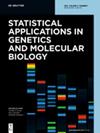当两个种群之间的等位基因共享相似性超过一个种群与自身的等位基因共享相似性时?
IF 0.4
4区 数学
Q4 BIOCHEMISTRY & MOLECULAR BIOLOGY
Statistical Applications in Genetics and Molecular Biology
Pub Date : 2023-12-11
DOI:10.1515/sagmb-2023-0004
引用次数: 0
摘要
遗传位点的等位基因共享统计量是将两个种群之间的差异作为随机配对个体之间差异的平均值来衡量的,每个种群中随机配对一个个体。由于种群内基因型的差异,等位基因共享相似度在计算种群与种群之间的相似度时,可能具有非零值的特性。我们考虑了一对种群中等位基因共享异质性的数学特性,并对两个种群中的等位基因频率进行了参数化处理。通过研究等位基因共享相似性的两种公式,我们得到了一对个体的种群内和种群间相似性的分布。然后,我们用数学方法探讨了在某些等位基因频率分布的情况下,种群内相似度(随机选择的种群成员之间的平均相似度)可能超过两个种群之间相似度的情形。这种情况有助于解释种群遗传数据中的观察结果,即一个种群成员之间的平均遗传差异可能大于另一个种群成员之间的平均差异。然而,数学分析发现,对于一对种群来说,两个种群中至少有一个种群的种群内相似性总是小于种群间相似性的值。我们将应用人类种群遗传数据来说明数学结果。本文章由计算机程序翻译,如有差异,请以英文原文为准。
When is the allele-sharing dissimilarity between two populations exceeded by the allele-sharing dissimilarity of a population with itself?
Allele-sharing statistics for a genetic locus measure the dissimilarity between two populations as a mean of the dissimilarity between random pairs of individuals, one from each population. Owing to within-population variation in genotype, allele-sharing dissimilarities can have the property that they have a nonzero value when computed between a population and itself. We consider the mathematical properties of allele-sharing dissimilarities in a pair of populations, treating the allele frequencies in the two populations parametrically. Examining two formulations of allele-sharing dissimilarity, we obtain the distributions of within-population and between-population dissimilarities for pairs of individuals. We then mathematically explore the scenarios in which, for certain allele-frequency distributions, the within-population dissimilarity – the mean dissimilarity between randomly chosen members of a population – can exceed the dissimilarity between two populations. Such scenarios assist in explaining observations in population-genetic data that members of a population can be empirically more genetically dissimilar from each other on average than they are from members of another population. For a population pair, however, the mathematical analysis finds that at least one of the two populations always possesses smaller within-population dissimilarity than the value of the between-population dissimilarity. We illustrate the mathematical results with an application to human population-genetic data.
求助全文
通过发布文献求助,成功后即可免费获取论文全文。
去求助
来源期刊

Statistical Applications in Genetics and Molecular Biology
BIOCHEMISTRY & MOLECULAR BIOLOGY-MATHEMATICAL & COMPUTATIONAL BIOLOGY
自引率
11.10%
发文量
8
期刊介绍:
Statistical Applications in Genetics and Molecular Biology seeks to publish significant research on the application of statistical ideas to problems arising from computational biology. The focus of the papers should be on the relevant statistical issues but should contain a succinct description of the relevant biological problem being considered. The range of topics is wide and will include topics such as linkage mapping, association studies, gene finding and sequence alignment, protein structure prediction, design and analysis of microarray data, molecular evolution and phylogenetic trees, DNA topology, and data base search strategies. Both original research and review articles will be warmly received.
 求助内容:
求助内容: 应助结果提醒方式:
应助结果提醒方式:


